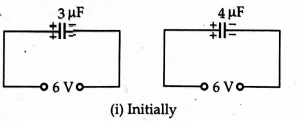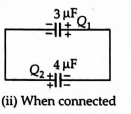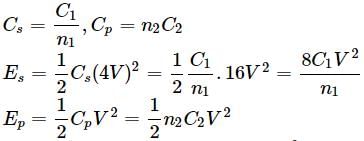Test: Energy Stored in a Capacitor (NCERT) - CUET MCQ
15 Questions MCQ Test - Test: Energy Stored in a Capacitor (NCERT)
A parallel plate capacitor is connected across a 2V battery and charged. The battery is then disconnected and a glass slab is introduced between plates. Which of the following pairs of quantities decreases?
A capacitor has some dielectric between its plates, and the capacitor is connected to a dc source. The battery is now disconnected and then the dielectric is removed, then
A capacitor of capacitance 700 pF is charged by 100 V battery. The electrostatic energy stored by the capacitor is
A 16 pF capacitor is connected to 70 V supply. The amount of electric energy stored in the capacitor is
A capacitor is charged through a potential difference of 200 V, when 0.1 C charge is stored in it. The amount of energy released by it, when it is discharged is
A parallel plate capacitor has a uniform electric field E in the space between the plates. If the distance between the plates is d and area of each plate is A, the energy stored in the capacitor is
A metallic sphere of radius 18 cm has been given a charge of 5 × 10−6 C. The energy of the charged conductor is
Two spherical conductors each of capacity C are charged to potential V and − V. These are then connected by means of a fine wire. The loss of energy will be
Two condensers, one of capacity C and other of capacity C/2 are connected to a V-volt battery, as shown in the figure. The work done in charging fully both the condensers is
A parallel plate condenser with a dielectric of dielectric constant K between the plates has a capacity C and is charged to a potential V volt. The dielectric slab is slowly removed from between the plates and then reinserted. The net work done by the system in this process is
Two identical capacitors have the same capacitance C. One of them is charged to potential V1 and the other to V2. The negative ends of the capacitors are connected together. When the positive ends are also connected, the decrease in energy of the combined system is
Energy stored in a capacitor and dissipated during charging a capacitor bear a ratio.
Two capacitors, 3μF and 4μF, are individually charged across a 6V6V battery. After being disconnected from the battery, they are connected together with the negative plate of one attached to the positive plate of the other. What is the final total energy stored
A parallel plate capacitor without any dielectric within its plates, has a capacitance C, and is connected to a battery of emf V. The battery is disconnected and the plates of the capacitor are pulled apart until the separation between the plates is doubled. What is the work done by the agent pulling the plates apart, in this process?
A series combination of n1, capacitors, each of value C1, is charged by a source of potential difference 4V. When another parallel combination of n2, capacitors, each of value C2, is charged by a source of potential difference V, it has the same (total) energy stored in it, as the first combination has. The value of C2, in terms of C1 is then






































